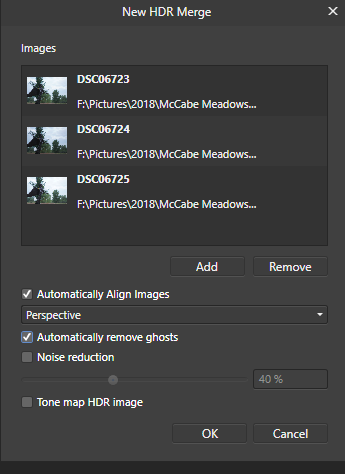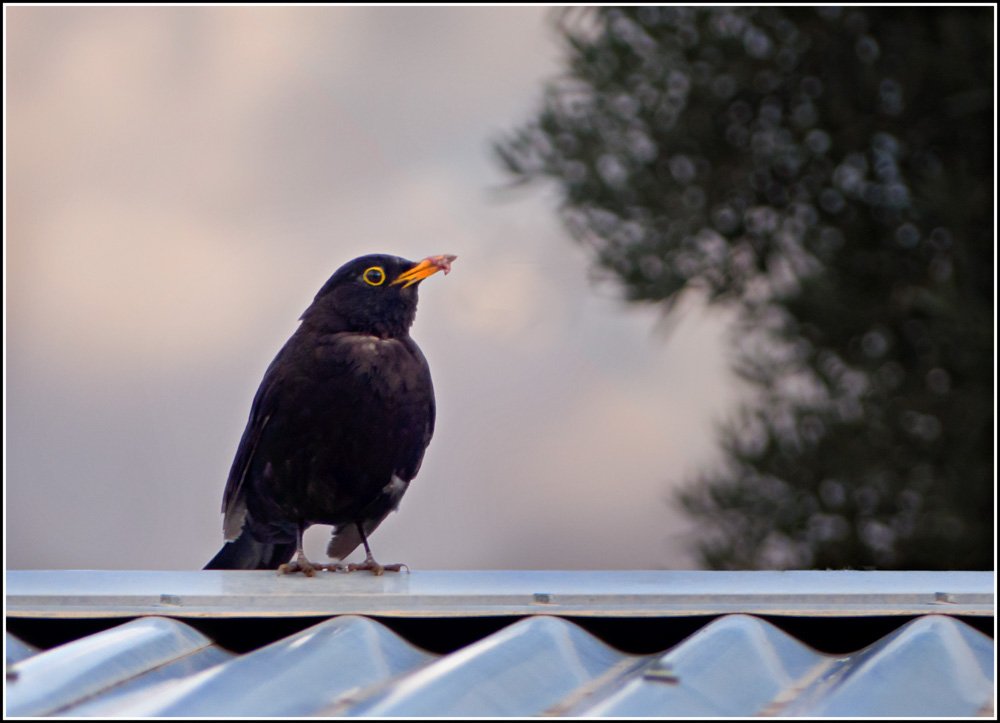Search the Community
Showing results for tags 'HDR'.
-
Hello, and sorry if this has been posted before. I got to capture a nice headland shot of a lighthouse. I set up the camera to capture 5 images in a burst - in JPEG and DNG format. When I use AF HDR merge function with the JPEG images - the image comes out correctly, with a relatively flat horizon However, when I use the DNG images - and the HDR process starts; a pronounced curvature is given to the image. Not what I am looking for. The original DNG flies are exactly the same as the JPEG, with the same horizon aspects. Any pointers please? This on Affinity Photo 1.8.3, using iMac OS Catalina 10.15.6 I've attached screenshots of the image to show what I am on about - you can plainly see in the HDR DNG images the upper corners of the image have dropped against the text.
-
Hej there, I am using an i7 Skylake with an GTX950M and 16GB RAM, still I get very very slow panorama and HDR renderings from Canon CR2 files. At the same time, very little CPU capacity is used (~15-20 %). Tonemapping panoramas takes easily a complete afternoon! I would love to see an performance upgrade in future versions (even if I have to pay for it). Otherwise, Affinity Photo is close to irreplacable as the generated images are excellent. Even the output using the default settings is much better than for example Aurora HDR, imho. Sincerely, Benedikt
- 2 replies
-
- performance
- affinity photo
-
(and 4 more)
Tagged with:
-
HDR with Photo and 32bit preview to true HDR monitor Asus PA32UCX. To output HDR from AP, you need to enable HDR On in WIn 10 to get the EDID working for HDR so the 32bit HDR selection is active in AP. But, what WIndows does is it seems to then create an ST2084 (PQ) to 2.2gamma EOTF to the monitor so SDR content looks correct. It then relies on the HDR content to be tagged correctly for the ST2084 EOTF to work. In AP, the HDR becomes active but with a 2.2gamma. I need to work in ST2084 for VFX/cinema/HDR for video. So it seems AP does not send a tag correctly to Windows to pick up the profile selection in colour settings. I have tried loading a ST2084 profile in both AP and Windows default etc and it always remains a 2.2gamma, not ST2084 EOTF. I have tried the OCIO config with ACES, but again it seems it is interacting with the ST2084 to 2.2G that Windows is applying. Any ideas please. HDR is not usable if the EOTF is wrong, regardless of getting the peak luminance to 1000nit and the primaries correct.
-
I would love if you could add a way to process timelapse sequences shot in HDR so that if I merge the three exposures and edit them as a 32bits file I can select a folder that contains for example 300 frames (1 in 0EV, 1 in +3EV and 1 in -3EV) and batch the same way that Photomatix does. This is an example of a timelapse frame that I have never been able to process because of this slow process. Here it is https://500px.com/photo/48376766/perfect-sunset-at-%22el-remate%22-by-fabriccio-diaz-?from=user_library I would love to process a 720 (3 exposure = 240 blended frames) HDR Raw Sequence and not having to manually edit each frame!
- 8 replies
-
- Photography
- HDR
-
(and 2 more)
Tagged with:
-
I am trying to merge 3 photos taken on a Sony a6300 and Affinity Photo keeps crashing. This happens every time I try to select these 3 photos. I am on the latest version of Affinity. I am attaching the hdr options I have enabled as well as a copy of my PC settings. I have Affinity setup to use my graphics card as the renderer. My graphics card is a NVDIA GTX 760. I have validated that the drivers on my graphics card are up to date as well. I have also uploaded the raw files to my google drive. They can be found here: https://drive.google.com/file/d/1VTGhsGbHLvUmMe2phK2Qg8OY1r_FpOgo/view?usp=sharing Please let me know if there is any other information that you need.
-
Hi, Using latest 1.8.3.641 on Win10-64, I try to HDR-merge 3 TIFF files, and the program crashes (closes abruptly with no message) early during the merge process, if auto-align is enabled. The TIFF files were exported by Capture One 20, originally from Olympus E-M1II RAW files. Oddly, merging those original Olympus RAW files directly in Affinity Photo succeeds, but unfortunately chromatic aberrations are not corrected so it's not a valid option. I attached crash report files. e6321abd-9b84-42a3-9c80-3eecd079bf61.dmp attachment_Log.txt metadata
-
Hi Affinity team. During the last days I tested the Windows version of Affinity Photo 1.5.1 and checked out those parts most important to me: RAW processing, HDR/Tone mapping and stitching Panoramas. (The video tutorials are great for newbies concerning your software.) I am happy to see all these features under a common hood and working reasonably well (although there are issues like the wrong histogram displayed in Develop persona which will refrain me from using Photo as default RAW software for now.) What I want to achieve: For years now I'm accustomed to create HDR images from a single RAW file instead a series of JPG or RAW files. The benefit is that there are no problems with motion (and thus ghosting) in the image, and no softness as a potential side-effect of the automatic alignment of handheld shots. Today's DSLR cameras create RAW images which can easily compensate 3 EV steps. (Depending on sensor size and ISO, the downside can be higher noise in dark areas, but that's acceptable for me.) My conventional approach is to develop 3-5 differently exposed JPG images (usually with different noise reduction settings) and then creating the HDR from these. This approach is very cumbersome with Affinity Photo, which does not even remember the RAW conversion settings I last used by default. Once a RAW file is developed, the Develop persona is closed and I have to start over for the next exposure. (In contrast to a dedicated raw converter like Canon's DPP or Nikon's NX-D where this is a no-brainer and easily done.) But maybe Affinity has a better approach? What if you could develop the raw file and apply a tone mapping without JPGs inbetween? Lets see, Photo Persona works in 32 bit, and RAW files can be developed to 32 bit HDR. Sounds promising. 1. I import the RAW file, disable applying the tone curve and leave the exposure-related settings untouched. 2. Then I put the developed 32 bit image into the Tone mapping persona -> Voilá, a developed HDR image. And what if I have a panorama of single RAW images which needs HDR processing? 1. You can start a "New batch job", select the RAW files to process and choose EXR as output format. 2. Then you can continue creating the panorama with "New panorama" and select the EXR files as shown in the HDR panorama video tutorial. 3. After the panorama has been stitched, it can be tone mapped in the Tone Mapping persona. Cool - this is a real time saver and more flexible regarding adjustments compared to my previous workflows which would mean first tone mapping every HDR image and then stitching the (hopefully equally exposed) JPGs together. Matthias.
-
Hi, I just HDR merged two .jpg and would now like to remove some artefacts by replacing them with things from the source images. I have activated Sources in Studio, but clicking on the Clone tool does not cause it to display the Sources panel. I'm using Affinity Photo 1.7.3 on macOS 10.14.6.
- 1 reply
-
- clone
- clone tool
-
(and 4 more)
Tagged with:
-
Hello, I have an older Olympus E-M5 and to make the most out of it I use bracketing to ultimately create HDR scenes. There is of course the challenge that the camera should be very still and stable when taking these photo's. Now, I mostly use AE bracketing with 5 successive shots with different exposures, and I end up with 5 raw images. When merging those into HDR picture it can achieve incredible high quality results, even for a camera that is more than 6 years old. My question is: can I simulate bracketing? I quickly tried by taking one jpg (not raw), tone down the exposures, save the images, and ultimately use those in HDR merge, with varying results. I guess doing these with raws should result in the same when taking 5 (or even 7) separate multi exposure shots? If simulating works, than I only need to take 1 shot. I won't be needing a tripod and a cable to a remote shutter button! Another question: does Affinity support batch processing raw files?
- 2 replies
-
- hdr
- bracketing
-
(and 1 more)
Tagged with:
-
Hi, I have tried to make an HDR image from 3 equirectangular images ( 360x180 panorama - stitched from AutoPano ). Problem: I got a line on the final image due to a difference between the pixels from the left and right sides. Is there a way to tell Affinity that the image is a 360 pano, in ordre to force the pixels from left and right sides to share the same values? - for example, the same way Photomatix has a checkbox... - The funny thing, is that issue does not show up always... Any suggestion? Thank you.
-
HI All, I have already seen the thread - But it does not seem to help me. I am using 1.7.2.471 version of Affinity and Windows 10 (Surface Book First Version). And the second copy is how it looks in default Windows Photos Raw viewer. Please help me what is wrong with this as, I used a batch processing on my RAW photos and they seem to look completely different if I try to do it one photo at a time. Thanks
- 7 replies
-
- affinity photo
- brightness
-
(and 4 more)
Tagged with:
-
After using the HDR function on a single image, I'm unable to export the image as it looks on my screen. What gets exported is a washed-out version of the image. I've tried this with several different images, and I even went back to the previous version of AP. I watched the tutorial videos on HDR and didn't see anything relating to this. In my screenshot, the image on the left is what I had after exporting, vs the image on the right, as I see it in AP. To get this, I just used File>New HDR Merge, chose a TIFF image, and accepted all the defaults. Then I used File>Export to a 16-bit TIFF. I also tried exporting to a JPG and got the same results. I assume I'm doing something wrong, but after a couple hours of trying to figure it out, it's time to ask for help.
-
I have an HDR 4k monitor. I've upgraded to Affinity 1.7. I'm loading a 32 bit image. But, the Enable HDR is grayed out and cannot be enabled. Any ideas? Thanks.
-
In the Affinity tutorial video, the process is very quick, all 7 incorporated images flash across the screen, and the final HDR looks good. On my iPad Pro 12.9’ current version, running the latest OS, the process takes four minutes, only a single frame appears briefly on the screen and then there’s just the progress bar, barely moving, and the final product after tone mapping looks crude and blurry. I have tried deleting and reloading to no avail. A single frame HDR simulation in Snapseed looks much better. (The 2 star review relates only to the HDR feature). Is it me? (Attempts to upload example failed.)
-
When I've an HDR Merge going on, I tend to head off to do other things. However, when I do this there's a tendency to come back later and the merge has frozen. Task Manager is then needed to kill AP. I'm guessing it's a memory-intensive activity (it clearly uses lots of processor cycles) and may be hitting the out-of-resource buffers. Still, it's pretty untidy just to hang.
-
My first post here, although I've had AP since the first Beta version came out. I have noticed over the last couple of months that my pre-sets for AP HDR were not listed on the left side of the screen, nor were the small accompanying images displayed which show an indication of what each effect looks like. I decided to reset AP by opening it up while holding down Ctrl, and clicking on reset all. Uh-oh, now I have no HDR presets showing. Help please! AP 1.6.5.123 Win 10 Pro version 1809 (64 bit)
-
Hi I am new in photography and using Affinity as well. I experiment with my camera and multiple focus points and multiple exposure . I am wandering using Affinity, what is the best way to create a very clear landscape photo with great DoF and to be HDR. The steps I have in my minds is: 5 different exposures for each exposure 9 different focal points then on Affinity I am thinking to merge the focal points first (grouped by exposure) , so I will get five new photos where each one now includes all focal points but has different exposure then I will do the HDR merge is this a right approach ? and how I control/decide the correct DoF (lets say is a landscape or night skyscrapers wig water in front or stars) many thanks
-
So I took a bunch of bracketed shots (five photo sets) and was converting them to HDR using Photo on my Mac on site (so people could see kinda what they looked like), its a, I think, early 2012 model, it WAS the top spec rMBP when they first came out so its not as much of a donkey as it might sound, but it was churning through the HDR merge and tone map fine, but to do my main editing I have a PC at home which is a 1700X Ryzen with 32gb DDR 4 and an NVMe SSD, not earth shattering, but decent. When I do the same exact HDR merge process on photo on my PC, its slower, like, noticeably slower, now I am assuming there is something wrong, like a setting or something somewhere that I have set wrong (I generally don't mess with settings though so pretty sure everything is default), surely there is no comparison in power between the two machines, but yet it takes longer on the more powerful one? Am I the only one who a) bothered to get affinity on both pc and mac and b) noticed this? Any tips? Cheers Charles
-
It's 44c hot here -- working up to 46c . the record is between 46 - 47c ; but will drop to a 28c tomorrow!! This is a true "grab-shot" that happened while doing other things. Made from the three bracketed files -- just time for one click with the camera held above my head. Honest comments and questions welcome as always
-
All the best for 2019mostly done in Affinity -- +Lr5. Not going to add too much here as I'm just putting a few thoughts to the test for better Panoramas and Manual hrd/blending as done in the top images. Hoping to share a few ideas sometime this year lol the panorama is west to east ; around 160 degrees. Around 6 -8 Pana Fz300 raw files . Handheld btw Starting to get the old head around Ap; yet there is so much I still need to get up to speed on Questions are welcome
-
when developing HDR images there is the danger that with RGB color mode you get color faults, because RGB represents color and luminance in the same value. If Affinity Photo would enable a LAB 32 bit HDR color mode that would solve the problem. Because color and luminance are now separated, the large dynamic range of HDR images are mainly reflected in luminance. This prevents color faults during HDR generation. By the way, I like the way Affinity Photo is adressing HDR development in the workflow. However, because I quite regularly get color faults during development, I can not use it in many situations (see attached image as an example for such a color fault in the sky). In this case I use my LAB 32 bit based HDR development programm (Oloneo), which produces nicer color without color faults.
- 1 reply
-
- hdr
- color space
-
(and 2 more)
Tagged with:
-
Hey, I have 3 pictures as tiff opened Affinity. Those are all taken with bracketing and was trying to convert those to HDR. I know this is kind of stypid but seems like there ain't option for merge layers as HDR only open as file. It ain't hard job me to just open those files that is true but was thinking is there change to add option for merge layers?




















